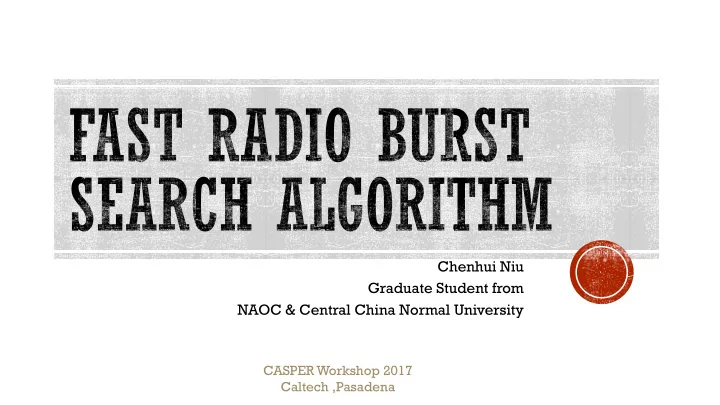

Chenhui Niu Graduate Student from NAOC & Central China Normal University CASPER Workshop 2017 Caltech ,Pasadena
What’s FRB?
FRB , Fast Radio Burst is a high energy physical phenomenon happened in our universe. Happened suddenly High Energy
How do we detect FRB?
§ Dispersion § Scatter § Scintillation
+7 − f 9:;< +7 ) ∆t = 4.15 ×10 +, ms / DM ×(f 456 Dispersion Measure: E 𝐸𝑁 = @ 𝑜 B 𝑒𝑚 F
source ISM 1 object 2 Antenna
source ISM 1 object 2 Antenna
Ο(𝑂 I / 𝑂 J / 𝑂 KL ) Ο(𝑂 I / 𝑚𝑝 7 (𝑂 I ) / 𝑂 J ) (Taylor, J. H. 1974, A&AS, 15, 367). Tree Time shift Algorithm Image Machine Processing learning Ο(𝑂 I / 𝑂 𝑢′ / 𝑚𝑝 7 (𝑂 I 𝑂 𝑢′) / 𝑂 J ) = Ο 2 / 𝑂𝑢 ′ / 𝑂 I / 𝑚𝑝 7 (𝑂 I ) / 𝑂 J = Ο 𝑙 / 𝑂 I / 𝑚𝑝 7 (𝑂 I ) / 𝑂 J
𝑻 𝟏 = (0,0) + (1,0) + (2,0) + (3,0) 𝑻 𝟐 = (0,0) + (1,0) + (2,1) + (3,1) Time Delay = 0 Time Delay = 1 𝑻 𝟑 = (0,0) + (1,1) + (2,1) + (3,2) 𝑻 𝟒 = (0,0) + (1,1) + (2,2) + (3,3) Ο 𝑂 I / 𝑂 J / 𝑂 KL In this situation, N t is 1 Time Delay = 2 Time Delay = 3
Time Delay = 0 Time Delay = 1 Ο(𝑂 I / 𝑚𝑝 7 (𝑂 I ) / 𝑂 J ) In this situation, N t is 1 FDMT Barak Zackay , [ The Astrophysical Journal, 835:11 (13pp), 2017 January 20 ] Time Delay = 2 Time Delay = 3
2 Dimensional FFT Algorithm! Collaborator : Ue-li Peng, Xuelei Chen, Yichao Li, Jayanth Chennamangaiam, Dan Werthimer, Jack Hickish, Casey law, Vishalkumar Rasiklal Gajjar, Greg Hellbourg etc.
(x , y ) (x’ ,y’) 𝑓 +YZ([\]^_) v 𝑓 YZ([`\`]^`_`) u 𝑓 YZ([`\`]^`_`) 𝑓 YZ([\ ]^_) Line(x,y) ⊥ L ine(u,v) • • Line(u,v) is always go cross center!
Rebin • • 2D-FFT Polar coordinates transform • Find signal •
+7 − f 9:;< +7 ) ∆t = 4.15 ×10 +, ms / DM ×(f 456
DM = 350
The straight line in re-bin map will become a straight line go cross center in 2D-FFT map. • Each angle present a special DM signal line . • • Signal line after FFT should not appear in First and third quadrant. So we only need the 2nd or 4th quadrant data. (it's conjugate to each other.)
Take the center of map as • original point Calculate angle and radius • length Interpolate the data with the • coordinates . Finally we can Get the polar coordinates matrix, and could plot it with angle and radius axis.
Sum it up along the radius axis from -90~0 • degree. • Calculate SNR. Compare SNR with threshold • Theoretical Input SNR is 320 Theoretical Input SNR is 32
As two lines perpendicular to each other, the two slopes k 1 , k 2 are also obeyed one rule:
Ο(𝑂 I / 𝑂 𝑢′ / 𝑚𝑝 7 (𝑂 I 𝑂𝑢 ` ) / 𝑂 J ) = Ο 2 / 𝑂𝑢 ′ / 𝑂 I / 𝑚𝑝 7 (𝑂 I ) / 𝑂 J = Ο 𝑙 / 𝑂 I / 𝑚𝑝 7 (𝑂 I ) / 𝑂 J § Compute complexity, this method is equal to tree algorithm § Easy to remove RFI § Easy to Parallelize (GPU)
§ Try second 1-D FFT to improve SNR § Try 2-D FFT first then do Radon transform to search a line. § Or try Radon transform directly to search a line or curve in frequency-time map.
In Xinjiang, North western China. We build 3 telescope cylinder + 16 dishes interferometer . 1 6× 2=32 inputs 96 × 2=192 inputs
Band Width : 100MHz Frequency: 700-800MHz Cylinder Scale: L 40m , Diameter 15m Dish Scale: Diameter 6 m FOV: 160 Deg 2 Time Resolution: 50ms Beam number: 32<N<96 Above 95% confident interval, We could see 0.05~4.5 FRB Per Month!
have Already Using SRIO to make a data copy. • • Beamforming by FPGA(GD2FPGA designed by IACAS). De-dispersion are processed by GPU Array. • search FRB High speed SRIO switch. • GPU server SRIO NIC • GD2FPGA GPU server NIC SRIO Switch
Recommend
More recommend